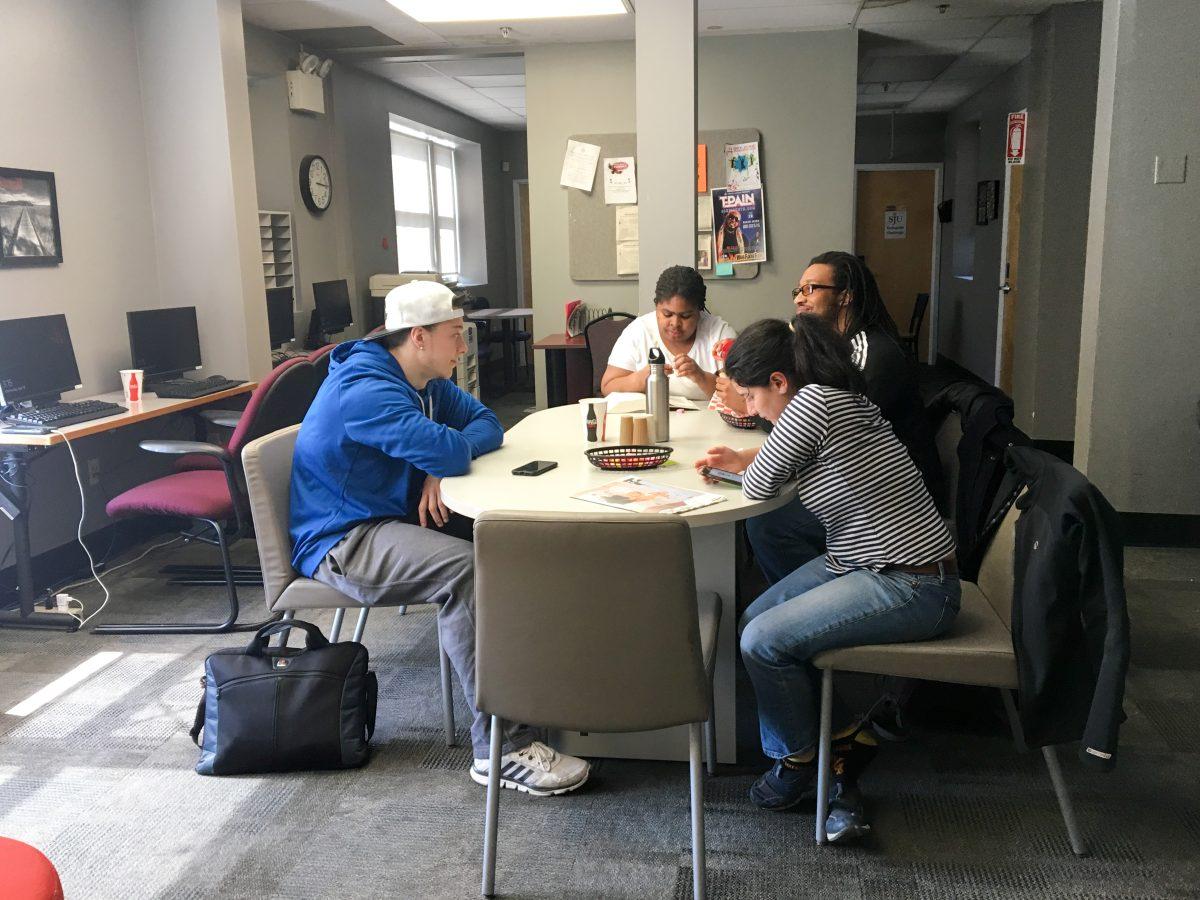Commuter Lounge serves students all day.
On a Monday afternoon around lunchtime, a group of students sat in a cozy room at the end of a hallway in Simpson Hall, eating, talking and watching Black Mirror on Netflix.
“If we’re not in class, we’re here, 13 hours a day,” Fatmata Sakho ’21 said, laughing when asked how much time she spends in the commuter lounge.
For Sakho and other commuter students, the lounge is their rest stop between classes, meetings and activities. It’s where they go to “do homework, eat, sleep,” according to Marly René ’19, president of Hawks in Flight, the commuter student organization.
“We come here because it’s a place of home on campus for us away from our actual homes,” René said. “Honestly, though, we get here at 7 in the morning, and we’re not leaving until 9, 10 at night.”
The lounge is separated into two parts. The door on the outside of Simpson Hall leads into the kitchen area, which has a full-sized refrigerator, microwave, sink, cabinets, a Keurig machine, and tables and chairs for dining. The other side is a study and hangout space with four computers and a printer, a large table, sofas and chairs.
In addition to the furniture, students have personalized the space with a whiteboard and bulletin board to write notes and post flyers for campus events. On the mantle above the closed fireplace sits a row of knick knacks and origami figures, which the students said are products of spontaneous arts and crafts sessions.
Many of the lounge’s features came from feedback and suggestions directly from the students.
“What the students told us loud and clearly was that they wanted a space of their own,” said Nancy Komada, Ph.D., senior director of Adult Student Life.
In its current location for about two decades, a space for commuter students was needed long before it was established, Komada said.
“I remember seeing students in the parking lots eating in the car,” Komada said.
Komada previously worked in Student Leadership and Activities, and while she was there, the office continually pursued initiatives to make commuter students feel more comfortable on campus. However, Komada said, many of these plans were not successful, including establishing intramural sports team, hosting commuters in residences halls for a night and placing lockers in McShain Residence Hall.
“All those things might have been great ideas, and a couple people liked them, but for the most part, people really wanted that space,” Komada said. “I think at the time, of all the initiatives that we did, that [commuter lounge] was one of the most successful.”
While the lounge offers commuter students their own space, it is not meant to isolate them from the rest of campus, said Beth Hagovsky, Ed.D. director of Student Leadership and Activities.
The lounge has two entrances: one that requires swipe access from the outside of the building, and an open door connected to a hallway in the Perch.
“We purposely did that because we didn’t want the commuters to feel or allow themselves to be closed off,” Hagovsky said. “We wanted there to be that fluidity between the rest of the campus and them. We wanted resident students and off-campus students to feel that if they made friends with commuter students, they’re just as welcome in their space as we would hope commuting students would feel in residential spaces with the friends that they make.”
Hagovsky said this location also offers commuters the ability to spread into the Perch and utilize that space as an extension to the lounge.
The lounge also offers the chance to form a community as commuter students.
Older students strive to help first-year commuter students by offering advice on a variety of topics, Vianca Salcedo ’20 said.
“We have conversations and a lot of debates,” Salcedo said. “We also do that to inform each other and educate, especially the newcomers.”
These conversations often focus on school topics in order to help first-year students still trying to adjust to college.
“We give them little tips here and there about what classes to take, classes to avoid,” René said.
Students not only go to the lounge to pass the time, but they also form bonds with other commuters, in part through the efforts of the Hawks in Flight club. The activities they have organized include movie nights, a Hibachi dinner and a “Friendsgiving” celebration.
While some of the events occur off campus or in other locations, the commuter lounge is essential to the organization, as it serves as the connecting force between the students.
“It does give us some sense of belonging on campus because as commuters, just the title itself gets us outcasted,” Salcedo said. “We definitely use this space to come together and feel like we’re part of campus.”
For Sakho, the lounge has served this purpose.
“I’m a freshman, so it was hard making new friends, because everybody lived on campus,” Sakho said. “When I came here, everyone was so nice to me, and it felt like a second home.”















































